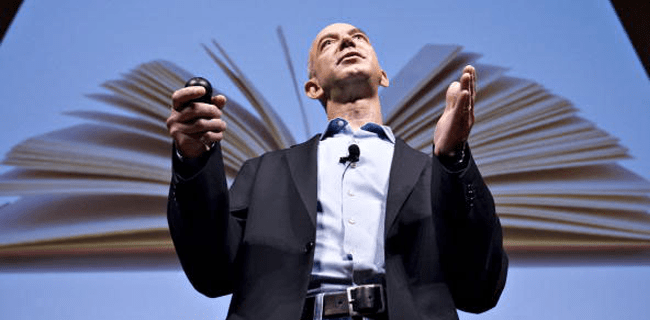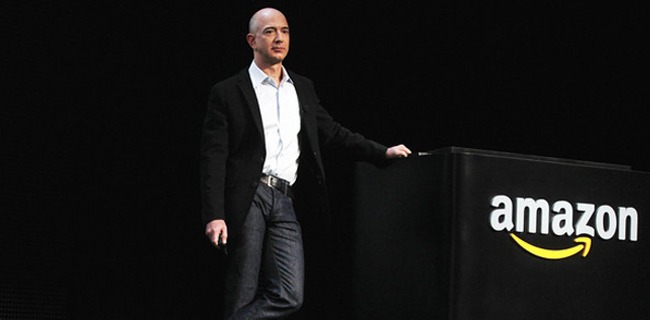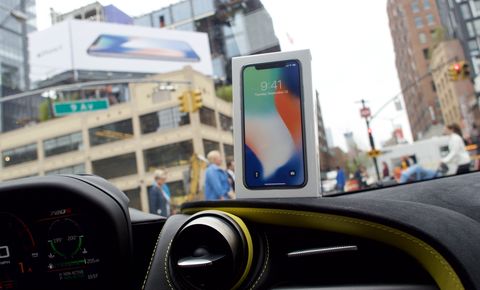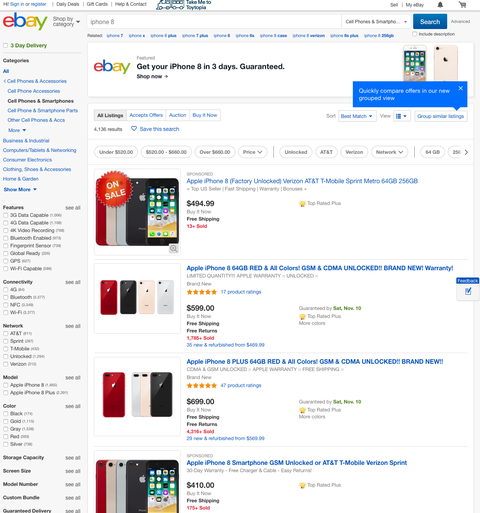What does it take to create the world’s largest online retailer, amass a personal wealth of over $83 billion, and be chosen as Time’s Person of the Year?
Better ask Jeff Bezos.He’s the founder, chairman, president, and CEO of Amazon.com. But he almost wasn’t. Below, I’ll share Bezos’ amazing story and 15 lessons from his life that you can apply to your own business.
#1 Act
It is only through deliberate action that we can bend the universe to our will.But there’s a common misunderstanding about action too: that we must know the exact right action to take before doing anything. This way of thinking leads “analysis paralysis” and inaction.
Bezos is not the type to fall into this trap. Though he’s well aware that taking the wrong action will have negative consequences, he doesn’t mind:
“If you decide that you’re going to do only the things you know are going to work, you’re going to leave a lot of opportunity on the table.”
Jeff Bezos, CEO & President of Amazon.com
He decided to drive across the country and buy the domain rights to Amazon.com. The rest is history.
As Amazon has grown, Bezos has encouraged his employees to err on the side of action. Sometimes this has resulted in pure brilliance (the development of one-click shopping). Other times it has resulted in total failure (the development of Amazon Auction, which couldn’t compete with eBay).
Bezos doesn’t mind the occasional misstep:
“We are willing to go down a bunch of dark passageways, and occasionally we find something that really works.”
#2 Minimize Regret
When Bezos was debating whether or not to quit his day job and start Amazon.com, he realized that he lacked an analytical framework for making big life decisions. So he made one up:“The framework I found which made the decision incredibly easy was what I called – which only a nerd would call – a ‘regret minimization framework’. So I wanted to project myself forward to age 80 and say, ‘Okay, now I’m looking back on my life. I want to have minimized the number of regrets I have.’”
Jeff Bezos, CEO & President of Amazon.com
“I knew that if I failed I wouldn’t regret that, but I knew the one thing I might regret is not trying.”
#3 Grow Slow
How long should it take before a startup becomes profitable? Maybe six months?For Jeff Bezos and Amazon.com, it took over six years. Even then, the company made only about $5 million in profit out of the revenue of over $1 billion.
That might seem like a long time (and a razor-thin margin), but it all went according to Bezo’s unusually slow-paced business plan. Bezos was in no hurry to rake in a profit because he wanted to keep prices low while reinvesting as much revenue as possible back into the company.
This strategy frustrated investors in the short-term but it paid off in a big way when Amazon survived the bursting of the dot-com bubble and started posting bigger profits quarter after quarter.
#4 Encourage Word of Mouth
When Bezos started Amazon he didn’t have a marketing budget. The only way his company would succeed was if it was so good that it spread by word of mouth.“If you build a great experience, customers tell each other about that. Word of mouth is very powerful.”
Jeff Bezos, CEO & President of Amazon.com
#5 There is Nothing More Important than the Customer
Everybody knows that the customer is always right. But Bezos and Amazon have taken the customer-first philosophy to the extreme. For Bezos, customer satisfaction isn’t just everything, it’s the only thing. It’s the very foundation of his business model:“The most important single thing is to focus obsessively on the customer. Our goal is to be earth’s most customer-centric company.”
Jeff Bezos, CEO & President of Amazon.com
“If there’s one reason we have done better than of our peers in the Internet space over the last six years, it is because we have focused like a laser on customer experience.”
#6 Charge Less
Some companies are always trying to find ways to charge you more. Just think of all the extra fees that airlines and car dealerships tack on to the advertised price.Amazon could probably make a killing with this strategy, but they don’t. Instead, Bezos tells his employees to find ways to cut costs and increase efficiency so that they will be able to charge their customers even less.
“There are two kinds of companies: those that work to try to charge more and those that work to charge less. One will be second.”
Jeff Bezos, CEO & President of Amazon.com
Before you charge more, do everything possible to make your business model cheaper and more efficient. You’ll help your bottom line and you may even be able to charge your customer less. That’s win-win.
#7 Never Stop Innovating
“What is dangerous is not to evolve”
Jeff Bezos, CEO & President of Amazon.com
His tendency to push the envelope has given Amazon.com a reputation as a nimble, always-evolving company.
Amazon started out simply selling books, but it hasn’t stopped expanding since its inception. Today, Amazon sells just about everything – but it also creates its own products, offers a host of web services, and even delivers groceries to your door (if you live in Washington).
#8 Be Flexibly Stubborn
“The thing about inventing is you have to be both stubborn and flexible, more or less simultaneously.”
Jeff Bezos, CEO & President of Amazon.com
It seems impossible to be both stubborn and flexible at the same, but that’s exactly what Amazon is. Bezos explains:
“If you’re not stubborn, you’ll give up on experiments too soon. And if you’re not flexible, you’ll pound your head against the wall and you won’t see a different solution to a problem you’re trying to solve.”
#9 Be Realistic
One of my favorite quotes is from Will Smith: “Being realistic is the most commonly traveled road to mediocrity.” The idea is that if you never allow yourself to imagine an extraordinary life, there’s no way you’ll ever obtain one.On the other hand, it’s possible to dream a little bit too wildly – and I think this affliction is particularly common with entrepreneurs. If you expect overnight success with minimal effort, you’re setting yourself up for never-ending frustration and disappointment.
As Bezos points out, being realistic about your business is also a way to ease the pressure of being an entrepreneur:
“It’s very important for entrepreneurs to be realistic. So if you believe on that first day while you’re writing the business plan that there’s a 70 percent chance that the whole thing will fail, then that kind of relieves the pressure of self-doubt.”
Jeff Bezos, CEO & President of Amazon.com
#10 Imitate
It’s good to be unique. But it’s even better to put a unique twist on something that’s already been proven to work.“We watch our competitors, learn from them, see the things that they were doing for customers and copy those things as much as we can.”
Jeff Bezos, CEO & President of Amazon.com
#11 Work Backwards

How do you develop a product that’s guaranteed to sell?
The best advice I’ve heard is to first figure out what your customers truly want and need. Provide that with your product and you’ll have no trouble selling it.
This is a strategy that Amazon has implemented many times, most famously with the Kindle e-book reader. Bezos explains:
“There are two ways to extend a business. Take inventory of what you are good at and extend out from your skills. Or determine what your customers need and work backward, even if it requires learning new skills.”
Jeff Bezos, CEO & President of Amazon.com
When Amazon released the first generation Kindle in November of 2007, it sold out within six hours (and remained out of stock for five months). To this day, Kindle remains the leader in the e-reader category and in November of 2011, they reported sales of “well over” one million sales per week.
#12 It’s Good to be Misunderstood
When you’ve got a business idea that’s destined to change the world (like Jeff Bezos did in 1994) there are bound to be people who just don’t get it. The more revolutionary your thinking, the more likely it is to be misunderstood.Bezos has particularly thick skin when it comes to this kind of thing:
“We’re very comfortable being misunderstood. We’ve had lots of practice.”
Jeff Bezos, CEO & President of Amazon.com
#13 Be Picky About People
One of Amazon’s core values is to have a high hiring bar. That means they only bring on a new employee if he/she is a perfect fit.“I’d rather interview 50 people and not hire anyone than hire the wrong person.”
Jeff Bezos, CEO & President of Amazon.com
#14 Be Far-Sighted
Bezos recognizes that “a lot of people believe that you should live for the now.” But he says, “I’m just not one of them.”He recommends that people “think about the great expanse of time ahead of you and try to make sure that you’re planning for that in a way that’s going to leave you ultimately satisfied.”
The Benefits of Long-Term Business
Amazon is a company that will sacrifice guaranteed profits today in hopes of scoring even bigger profits decades from now. Bezos has said that “sometimes we measure things and see that in the short term they actually hurt sales, and we do it anyway.”Here’s his reasoning:
“Every time the math tells you that you shouldn’t lower prices because you’re going to make less money. That’s undoubtedly true in the current quarter, in the current year. But it’s probably not true over a 10-year period when the benefit is going to increase the frequency with which your customers shop with you, the fraction of the purchases they do with you as opposed to other places. Their overall satisfaction is going to go up.”Bezos would rather charge people less today so that they will use Amazon again tomorrow.
#15 Make History

“I’m not near the end of the story.”
Jeff Bezos, CEO & President of Amazon.com
Bezos is out to make history. And if you want to find similar success, you’ll have to adapt his “go big or go home” attitude. I’ll leave Bezos with the last words:
“Work hard, have fun and make history.”





